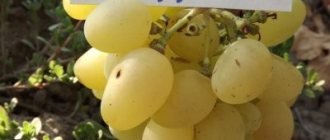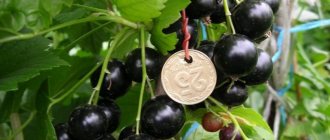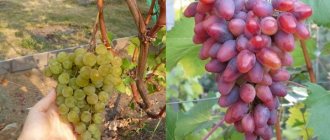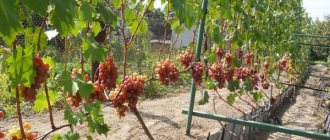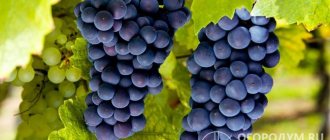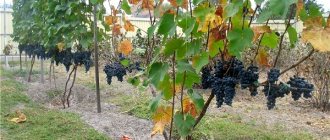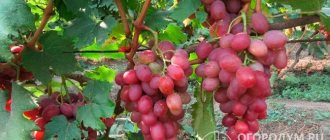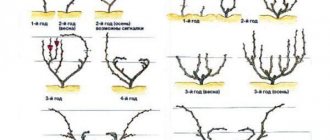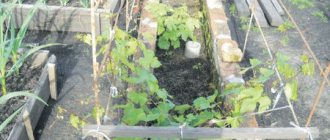Variety and appearance
Regent is a wine or technical grape variety that can be characterized by medium-late fruit ripening.
Berries can be harvested after 130-140 days from the growing season. The bushes themselves are characterized by medium growth vigor, strong and fairly wide branches. There are not many stepchildren. The leaves are large or medium-sized, five-lobed, jagged along the edges, green with light yellow veins.
The clusters are not large, on average 170-180 grams, the density is moderate, the shape is cylindrical-conical. The berries are round, black (sometimes dark blue), berry weight is on average 1.5 grams. The pulp is juicy, rich, and has a light nutmeg and herbal aroma. Intensely colored juice. Fruits accumulate sugar well. Ripe grapes with an acidity of 8 g/l contain an average of 22% sugar content.
Description of the characteristics of the Carnival grapes
In terms of ripening time, the form is declared to be very early, however, at the time of 2021 it was possible to observe only in the grafted version, so to confirm the characteristics it is necessary to see an adult bush in its own root version, which takes time.
The clusters are very beautifully made, conical in shape, separate with branches. The berries are located quite close to each other and stick out like a hedgehog, but do not crush each other.
The berry is elongated, thin with a slight interception in the middle, sometimes curved, popularly called a “lady finger”, red in color. The length of the berry can reach up to 4 cm and weigh up to 12 grams. The pulp is fleshy and juicy with an easily eaten skin and a pleasant harmonious taste.
On different rootstocks, winegrowers develop color differently. For some, the berry turns dark when overripe, while for others it remains red.
A distinctive feature of the hybrid form is its “insane” yield. All eyes, starting from the first ones, are fruitful and produce 2–3 inflorescences. After grafting, in the first year I showed up to 2 full-fledged inflorescences per shoot, this is the first time I’ve seen this.
Therefore, loading the Carnival bush with a harvest will not be difficult. Even with compact bunches, it is quite possible to get more than 1 kg from a shoot. However, we must not forget that it is necessary to load the bush adequately for the development of the bush, even with great growth force.
In addition, remember the fact that when overloaded, we sacrifice ripening time, external data and the future harvest. Therefore, measures such as rationing will not hurt.
An important fact when choosing a variety is the full pollination of the bunches, as well as the resistance of the berries to cracking, which cannot be taken away from Carnival.
I haven’t checked the winter hardiness because I don’t see the point in it. You shouldn’t expect outstanding frost resistance from European-Asian hybrids; I think it will be at the level of others. Disease resistance is quite good; with standard treatments before and after flowering, no signs of damage were observed.
back to contents
German Regent - technical grape variety
The Regent grape appeared relatively recently, in 1967. This interspecific hybrid was bred as a technical variety by professional German breeder Gerhard Alleveld.
In the short period of its existence, this vine has managed to spread throughout the world and become a favorite of many winemakers.
This variety does not pose complex and time-consuming tasks for the gardener, which, coupled with strong harvests, evokes only positive feedback from grateful winegrowers.
Characteristic
When describing this variety, it should be noted that, despite its technical purpose, it has a pleasant taste and is suitable for table use.
Maturation
The grape variety "Regent" is a species with a medium-late ripening period. The growing season averages 130-140 days. Ripening occurs at the end of September. It has very high yields, because more than 80% of the shoots bear fruit, which is rare for grapes.
By the end of September, the bush acquires an abundance of black, blue, medium-sized clusters. Their small mass, about 170 g, is more than compensated by their abundance. The clusters look like inverted cones and are symmetrical.
Each berry has a regular round shape and weighs approximately 1.5 g. The grapes are covered with thin skin. Underneath there is crispy flesh. It has a light blue-violet pigmentation, which is a very important factor for successful processing. It is the pigments that give wine and grape juice a bright and rich color.
The pulp has a medium-dense, elastic consistency and a pleasant, bright taste. Many gourmets find notes of nutmeg and fresh herbs in it.
Due to the high degree of sugar content (20-22%) and sufficient acidity (7-9 g/l), they are suitable not only for processing, but also for food purposes.
When ripened grapes remain on the vine for a long time, their sweetness increases significantly, which negatively affects the quality of processed raw materials, but improves the taste characteristics.
Wintering
This vine has a high degree of frost resistance. It is able to survive temperature drops down to -27-280C without any shelter.
There is a popular opinion among gardeners that 1-3 year old seedlings need insulation.
For this purpose, some experts recommend using both banal sawdust in a 5 cm layer, and taking more serious measures - laying it on the ground and wrapping the vines with agrofibre.
Durability
Its resistance to diseases and parasites allows “Regent” to occupy a leading position among technical varieties. It exhibits high resistance to gray rot, downy mildew (mildew), powdery mildew (oidium) and phylloxera.
In European countries, there are entire wine farms that produce wine from organic grapes.
It is the resistance of this variety to diseases that allows it to be grown without pesticides, fungicides and other chemicals.
Minuses
To complete the description, some negative aspects of this variety should be clarified, which can be easily eliminated with proper care:
- Tendency to shedding. After full ripening, the connection between the grapes and their stalks weakens. This significantly reduces harvest time;
- Loss of acidity. If you leave the bunches on the vine, they begin to rapidly lose their acid level, which will negatively affect the taste of the wine and compote;
- The yield of "Regent" greatly depends on the composition of the soil. This variety reacts painfully to the depletion of nutrients in the soil, especially Magnesium. This problem can be easily solved by regular feeding.
Landing
The main condition for the successful survival of sprouts and a high degree of bush productivity is the choice of soil and regular care of it. Planting dates are quite vague - from March to mid-July.
- A few months before planting, experts recommend enriching the soil with minerals. For this you can use Magnesium Sulfate or dolomitic limestone.
- For planting, it is worth digging a hole with dimensions of 80x80x80 cm. A distance of at least 2-3 meters must be maintained between the landing sites. This species, despite the average height of the bushes, has a wide and strong rhizome, which needs space for growth and nutrition.
- An 8-10 cm layer of pebbles should be placed at the bottom, which will serve as drainage, and cover it with earth (5-8 cm).
- The next stage is fertilizer. A combination of organic humus, manure and superphosphate with potassium salts is ideal for this.
- The seedling must be placed at one end at the bottom of the hole along with a peg, which will serve as a support for it. After planting, the cutting must be tied to it.
- Abundant watering, at the rate of 10 liters of water per plant. It is performed at the moment when 1/3 of the hole is filled with earth.
- If your area is characterized by dry summers, then you should create a mound around the seedling, 15-25 centimeters high.
- Peat crumbs are added to the moist soil on top.
Despite the unpretentiousness of the plant, it is still a cultivated, individually bred variety that cannot exist without outside help. The care package includes the following activities:
- Pruning will help the plant survive winter and frost as safely as possible. It is produced in the fall. The annual vine is cut 3-5 cm above the lower eye. This will help in the future to form a bush of the correct shape. Adult plants do not need such drastic measures. It is necessary to remove all green young shoots, and shorten the old branches by 2/3 of their original length.
- Spring thinning is done by breaking off damaged and weak shoots. This will give the vine the opportunity to concentrate on healthy, fruit-bearing branches. It is carried out after the tendrils and inflorescences have been driven out.
- Topping. Removal of shoot tips is done 6-8 days before flowering. In this way, gardeners activate the growth of lateral branches.
- Pinching is carried out after pinching. Removing excess side shoots will increase the yield of the plant.
- Before wintering, you should cover the root zone of the soil with organic fertilizers mixed with sawdust.
This variety is loved by winemakers for the premium dry red wine that is made from it. Such a drink will have a rich nutmeg taste and rich aroma, which are given to it by tannins and extractives. Color saturation also plays a big role among connoisseurs of richly colored wines.
There is a method for making rose wine. It is distinguished by light raspberry notes in the aftertaste and fruity aroma.
The grape product obtained through processing has a high percentage of usefulness.
Read more: Which looks bigger, an apricot or a peach? What is healthier - apricot or peach? What is curly disease
It has a large amount of antioxidants, vitamins and active pigments that promote active mental and physical activity.
There are a huge number of species, but German breeders developed the hybrid technical grape Regent, a description of which is presented below. It is intended not only for food consumption, but also for making wine.
| Purpose of the variety | wine |
| Acidity of the variety | 8 g/l |
| Sugar content of the variety | 22 % |
| Bunch shape | cylindrical cone-shaped |
| Bunch weight | 180 g |
| Berries shape | round |
| Berry color | black with a bluish tint |
| Berry size | 1 - 2 g |
| Taste | pronounced nutmeg and fresh herbs |
| Ripening period | end of September |
| Frost resistance | up to -28 degrees |
The Regent variety is a relatively new wine variety whose berries ripen at the end of September.
- Description of berries. The fruits are round, small in diameter. The color of the thin skin is almost black with a bluish tint. The fleshy part is much lighter - blue-violet. The berries are distinguished by their juiciness, rich taste and aroma. The unusual taste lies in the pronounced nutmeg and fresh herbs. The weight of the fruit ranges from 1 g to 2 g. The taste characteristics of the berries are a high percentage of sweetness (22%) with moderate acidity (8 g/l).
- Description of bunches of grapes. The cluster of berries is represented by a cylindrical cone-shaped shape. During its formation, a large number of fruits are not laid, so after ripening the bunch weighs no more than 180 g.
- Description of the leaves of the variety. The organ for photosynthesis in plants grows to a medium or large size. It has a rich green color with light green veins. The tips of the leaves are represented by teeth of different sizes.
To obtain a high-quality harvest, the Regent bunches should be picked on time, without leaving them to overripe. Otherwise, the berries will crumble and lose acidity, which is important for creating a subtle aftertaste in wine.
The Regent variety is very demanding on soil and care. Annual feeding should be carried out with a high amount of magnesium and other nutrients important for grapes.
High resistance to dangerous and common pests allows the Regent variety to be grown without the use of pesticides, but with the use of fertilizers that increase plant immunity.
Landing
As already mentioned, the Regent variety is very capricious in relation to the soil, so before planting a seedling it is worth fertilizing the soil with dolomite or magnesium sulfate. It can be done in spring or autumn when planting.
- The process of planting this variety is not much different from the other, so a standard hole is dug in the form of a cube, the length, width and height of which are 80 cm.
- A peg is driven into the center of the hole to securely fasten the seedling and a drainage layer is created with medium-grain gravel up to 10 cm.
- Next, a cover of soil, also 10 cm thick, is poured.
- Next comes the laying of organic fertilizers (manure, humus) - 3 buckets. At this point, mineral supplements with the main active ingredient magnesium can be added. It is possible to add 300 g of superphosphate and 10 g of potassium salts. It is better to separate the layers of fertilizers with a flap of ash.
- The soil is filled up to 1/3 of the hole and watered abundantly.
- The plant is tied to a stake, around which it is necessary to create a small hill at ground level.
- The roots are straightened and the seedling is dug in with moderate soil compaction.
- Peat fertilizer is applied around the trunk.
- In the southern regions, the Regent variety is protected from drought by hilling to a height of 15–20 cm from ground level.
Care
Despite the unpretentiousness of the plant, it is still a cultivated, individually bred variety that cannot exist without outside help. The care package includes the following activities:
- Pruning will help the plant survive winter and frost as safely as possible. It is produced in the fall. The annual vine is cut 3-5 cm above the lower eye. This will help in the future to form a bush of the correct shape. Adult plants do not need such drastic measures. It is necessary to remove all green young shoots, and shorten the old branches by 2/3 of their original length.
- Spring thinning is done by breaking off damaged and weak shoots. This will give the vine the opportunity to concentrate on healthy, fruit-bearing branches. It is carried out after the tendrils and inflorescences have been driven out.
- Topping. Removal of shoot tips is done 6-8 days before flowering. In this way, gardeners activate the growth of lateral branches.
- Pinching is carried out after pinching. Removing excess side shoots will increase the yield of the plant.
- Before wintering, you should cover the root zone of the soil with organic fertilizers mixed with sawdust.
Selection and place of breeding
The Regent grape is a complex interspecific hybrid of German selection. The variety was bred in Germany, at the Geiweilerhof Institute of Viticulture, where German breeder Gerhard Alleveld crossed two grape varieties: Diana and Chambourcin in 1967. This is why the Regent in literature can be called Geiweilerhof 67-198-3.
The Regent grape variety is common in Germany and America. It is also grown in Russia and neighboring countries.
Hybrid forms of the regent are the varieties Rumba, Mavr and Citron magaracha.
For the northern regions of our country, this variety is not recommended, since in terms of ripening it is considered medium-late, and may not have time to fully ripen during the summer period.
Which grapes are suitable for growing in Siberia
The same Amursky, or Isabella, have taken root well in Siberian latitudes. But there are other varieties that produce good results in this region. Nuances of care and planting of grapes in Siberia.
Purple early
Its juice produces dessert wines with the aroma of Muscat.
- The harvest ripens in 4 months;
- purple fruits with a nutmeg aroma, weighing up to 3 grams;
- the amount of sugar in berries is up to 20%
- the bush is resistant to freezing down to – 30 degrees;
- the plant is rarely susceptible to diseases;
Alpha
Outwardly resembles Isabella. The yield is about 2 kilograms per bush.
- Ripens in about 5 months;
- fruits are dark purple, weighing 1.5 grams;
- bunch weight is about 100 grams;
- sugar content in fruits up to 16%
- tolerates up to 45 degrees frost;
- good disease resistance.
There are many more grape varieties suitable for winemaking than are described in the article.
Those who like to make homemade wine from grapes do not have to live in the southern regions. This sunny berry can also be grown in northern latitudes. You just need to choose the right variety and help the plant a little to take root in a climate that is foreign to it.
Regent grapes: description of the variety, care features, how to grow the variety
The bushes of the Regent plant require close attention. The shoot care process includes:
- Pruning. Thinning of the vines is carried out in the fall. Using pruning shears, the non-lignified side shoots are removed, but the woody ones are shortened at a right angle by 2/3 of the length. Annual shoots are pruned 3 cm above the lower eye.
- Breaking off. The event is carried out after the appearance of tendrils and inflorescences. The variety needs to remove weak and damaged branches. Young growth also requires partial debris.
- Pinching the tops. This is necessary for the productive development of grapes to the sides, and not in height. The process is carried out a week before flowering.
- Stepsonning. After pinching, the Regent variety actively leads to the formation of stepsons, which additionally load the bush. Partial removal is carried out.
In winter, Regent needs additional nutrition, so autumn feeding with organic fertilizers and sawdust in a 5 cm layer is recommended.
The description of the Regent grape shows that proper care is very important for this variety. It can be described as follows:
- Pruning side shoots and those parts that are already woody. This cutting must be done at right angles.
- After flower tendrils form, damaged and weakened stems need to be removed.
- About seven days before flowering, you need to remove the tops of the shoots and pinch them - this will improve the flow of nutrients to the bunches of berries.
- Excess stepsons need to be removed in a timely manner, as they consume useful microelements, preventing the grape bush from developing and the berries from growing. Also, stepchildren often provoke the development of fungal diseases and the appearance of felt mites on the leaves.
- In winter, grapes may lack nutrition, so in the fall it is advisable to feed them with nutritious organic fertilizers - manure, compost or peat.
For those who value wine more than all other alcoholic beverages, the determining factor in their choice is the grape variety from which the wine is made.
You can experience all the variety of tastes of wines from different varieties of wine if you attend a real tasting, but if you do not have this opportunity, we suggest that you familiarize yourself with information about the best wine grape varieties.
This famous white grape variety, whose name everyone knows, originated in wine regions such as Burgundy and Champagne. Its main difference lies in the richness of the aromas of the second and third plan, which are formed during the production of the drink.
Depending on what technology is used to make homemade or factory wine from the Chardonnay variety, it may have different features:
- turn out to be very light, with the aroma of light fruits, in particular citrus fruits, and notes of flowers;
- thick, even somewhat cloying, accompanied by the tastes of honey and baked goods;
- if the wine is aged for a long time, hints of dried fruits and hazelnuts also appear;
- when using good oak barrels, notes of butter and toast are added to the taste;
- if aging is done in glass containers, then the taste is complemented by the aromas of Oriental spices, cream and hazelnuts.
It is Chardonnay that, according to experts, is the best grape variety for wine (including sparkling wine), since its berries are very resistant to various mechanical influences, maintaining taste and aroma.
The ideal time for planting seedlings of the future Chardonnay is spring, when the earth is well warmed up and the air temperature is stable, and autumn before the onset of frost. These grapes ripen within 130-150 days at a total of active temperatures of 2800-3200 degrees.
On average, the weight of one berry is three grams, and a standard bunch is one hundred and eighty. One bush can produce more than fifty fruitful shoots.
Read more: Bianca grapes: variety description
When planting, give it a little more space than other varieties so that enough light reaches the vine.
This wine grape is also light in color and comes from Hungary. Due to the fact that the ratio of sugar and acidity in it is quite good, it can be used to produce high-quality white wines - from semi-sweet to strong dry. Bianca is also used as a raw material in the production of cognac and vodka made from grapes.
The optimal time for planting this variety in regions such as the Russian south or Ukraine is the end of March. In this case, the soil temperature should be at least eight degrees Celsius, and the average air temperature should be no more than ten degrees Celsius. For the middle zone, mid-April or October is ideal.
Bianca is a very fertile and productive variety, more than eighty percent of the shoots on the bush are fruitful, the berries are sweet and juicy.
This grape variety was first bred in Germany in the late sixties of the last century. Unlike the previous ones, it has a black-violet color and is very juicy.
It is impossible to say exactly what time will be the most suitable for landing the Regent. Many experts prefer to do this in the spring, when a large amount of sun affects the strengthening of the seedling. Features of the variety:
- ripening period is medium late, about one hundred and forty days;
- yield level - more than eighty percent;
- the taste of the berries is harmonious, accompanied by hints of herbs;
- Regent wine is of the highest quality, on par with Pinot Noir.
When growing Regent, it is unacceptable to use any chemicals to treat bushes against pests and pathogenic bacteria, therefore, vintage wine made from berries is considered environmentally friendly.
The homeland of this noble variety is Burgundy. Its clusters are distinguished by the fact that they are not at all large, with a length of seven to twelve centimeters and a width of five to eight. The berries are quite large - about one and a half centimeters in diameter, bright blue, with thin but strong skin and sweet, juice-rich pulp.
The juice from the best Pinot Noir wine variety is a colorless liquid with a refined and harmonious taste.
Pinot Noir can be planted in the same way as other grape varieties: in the spring from March to May, in the fall - from late September to early November. This is a late species, and it ripens within five months at a total active temperature of 3000 degrees. The main difference between this grape is that it is very demanding in terms of planting conditions.
Noble varieties of white, rosé, and red wines are made from Pinot Noir. These include both sparkling and table varieties, which have a light but very rich aroma with hints of fruit.
Experts note that this exquisite grape variety is very unpredictable, and it is simply impossible to predict in advance exactly what the taste of the finished drink from it will be.
Let us immediately note a number of characteristic features of this ancient grape variety, which is also one of the most popular in our country and surrounding areas:
- The size of the berries is medium and large, the color is dark blue. They have thin skin and juicy pinkish flesh.
- The height of the bush is above average, the weight of one bunch is approximately one hundred and fifty grams. Able to grow in almost any soil, easily adaptable.
- The taste of the finished wine is rough and very unusual, unlike the options described above, it requires long aging. This is due to the fact that the excess amount of acids present in the grapes when harvested is retained both during fermentation and during aging.
It is best to age Georgian Saperavi wine for a minimum of five to a maximum of thirty years, so that the taste noticeably improves and acquires creamy shades and raspberry aromas.
It is important to know the characteristics of certain wine grape varieties in order to be able to independently grow the crop and make delicious homemade wine from it. In addition, such knowledge can be useful when choosing the appropriate drink for a feast or dinner in a restaurant.
Georgian Saperavi wine is truly unusual. I vacationed in Georgia, in Kakheti, and visited local vineyards. This variety is popular there. 90% of all red grapes are saperavi. The Ojaleshi variety also grows, but it is rare. And they age the wines not in wooden barrels, but in clay ones. But the Regent variety grows in our dacha. I just don’t write it very well, but it’s just right for wine
Forum statistics
207036 Messages in 1634 Topics from 5593 Users. Last user: Amaya Last message: “Let's talk about the weather in Vash...” ( Today at 07:52:22 ) Latest messages on the forum.
Now on the forum
36 Guests, 10 Users
Users in the last 15 minutes: Quiet, Svetla777, 64nikolay64, Marshal, Nikolay S., therapist, Liza, lomakin1969, Alexander Vl., Elvira2017 [Blocked] [Section Moderator] [Forum Moderator]
Maximum online today: 77 . All-time maximum online: 2758 (28 July 2021, 17:22:51)
Users who visited the forum in the last 24 hours
Total: 295
(Visible: 294, Hidden: 1) 1963, Quiet, Svetla777, 64nikolay64, Marshal, Nikolay S., therapist, Liza, Capricorn, lomakin1969, Alexander Vl., Elvira2017, Andrey76, Slavka, Mikhail77, ElenkaF, Tatyana B, Alex65, Cherkessk, Eugene, zsb, leonidych, vladimirM, yotmast, mers, Serg1707, SNovichek, hanter64, znakomij, Alexander K, Vardan, Sergey Fer, Anatoly Sivkov, Alexey V, Ilya 77, Andrey Gladilin, Tatyana A., Belgorodets, in Astrakhan , Oksana Kopp, sem_en, Vladimir 153, skier, Igor Viktorovich, slavalimon, Primorets, OlgaOs, SANYCH, 31rus, mystic69, DorontsovPeter, Andrey Tsvetkov, Buba, igor222, Elena Z, vlad51, Kenig, Nikolay Rex, Sergey 1965, Vladimir Buturlakin , DSW, psv1960, Dmitry 77, Vasily V., Vyacheslav03, Natalia Nikolaevna, Sergey Tashchiyan, Igor Sergeevich, alexsandr, kvg, Pioneer, Ekaterina Polyanina, nicson7, Elena Aleshchenko, Alexander-ask-34, Verona, Igor F., Taker , Henry, Yuri72, L.A.P., Gaivoronsky Yuri, Sergeevich, Sergei Chistokletov, Svetlana Streletskaya, Galinka, Alexey Deminov, Naumov Igor, Vyacheslav136, Gloomy, Katrin, AndSanych, Mikhno Alexander, Ded31, Filippov Oleg, Vladimir ++ , Mikhail Alekseevich, Lydia58, ALEXANDER BRYANSKY, Vladimir-kanevskaya, DIL, Amber7394, Marina Protasova, TITOVA LYUBOV, Linx, alexander66, Natalya M, Mikhail Fesenko, Amaya, Alexander71, Boris 1952, tsv, Maximilian, 25nata35, nadia, GALINA A NOKHINA , Igor_K, Alexander Kolesnikov, Ivan Levin, Pitko, weather forecaster, eSAa, cecet71, atseton, Alexander Smirnov, Vladimir Kostochkin, Vladimir Berdnikov, Gocha, pioneer-2, LeXa_KoT, Sergey 61, Sergey Yuryev, Erem, alexss, Evgeniy52, Skif, Vladimir Kovba, dayton, Yuri Semyonov, N.A. Sokolov, Pavlentiy, Sa-shura, Volgogradka, Dmitry Anatolyevich, Grandfather Igor, Andrey Lis, Bublichenko Alexander M, Marina Krymskaya, stenlly2010, irahelm, Vyacheslav Vladimirovich, Vladimir Shilov, Aprel, Badaev Dmitry, gheo55, Yura, y_fed, rambo, Yagodka, Valentina Ivanovna, Kryn, oleg9f, DED2, Svetlana Korotina, Zavezen Oleg Ivanovich, Eduard., santra, L2k2m7n, Alexander48, Viknik, Andrey 31, m2d, Valery Rastorguev, Soshnin Yura , Amateur gardener, Galina, Vasily1111, gardener, marlin64, Salex, sergei, Sergey Ko, Ramiz, viktor_, kosmos, potap05, Yuri 36, VitalySD, Inna161, Vova Kapran, Vladimir Shcherbinin, Valerie, niy1, cfibr, Andrey68, kulol3 , thanatos, Serzh1978, Realist, Artur53, max2008-01, LOZA, AlexanderD, Grandfather Young, Natasha, Zayac, ketch, Rita, alx-74, Iv Iv, Alexander150, Igor K, Vasily Viktorovich, VeraNiK, kdm57, Veniaminovich, Boris Sokolyansky, 77volt, , vikbublik, neposny, Evgen, Victoria Aleksandrovna, Serezha 64, Wintel, Airbone, teri, Sergey Lomonosov, Khramov, serginio, Leonty Yarygin, Irina O., Ser, Nadezhda Grig, Lyubov S., netolya, Saisan, Agryzkov Alexey, Vadi, Zinaida, Vadim, Alexander Taganrog, Sukhonos Sergey, Snezhinets, evgen_26, nau_63, Masha_gardener, Gennady163, krasnovlad1, Alexander Zinoviev, Vasily 53, Roman Fedorovich, TIS, Alexey Sergeevich, arnyusha, Zheka, Nurtas, kradievska, nick041 , Valentina Medvedeva, Sergey43, Andrey S., Nikolay Lipunov, Mst, Vertuoz2, Vladimir VS, NatalyaMed, freesia, Kinna, Mikhail Michurinsk, alekcsan1, VALERY TAMB, Sasha57, MikhAf, Y_Azer, Andrey Beribesov, hunter1955, nut lover, Keys, Ivan Shmelev, Pestik, anton_slash, Nadymchanka, Sergey 31, Volgar, Pavel 64, Tatyana Volzh, Elektronik_t, Alexander 61, spotlight, Alexander Guy, Cheprak, Pirko Alexander, vladimirvrn
Landing
To properly plant Regent grapes, it is enough to follow the general rules that apply to all varieties. You need to dig a cubic hole approximately 80 cm high. A stand is placed in the center to later secure the seedling. Gravel of small fractions is suitable as a drainage layer.
After drainage, add manure, humus or peat - about three buckets with the addition of mineral fertilizer with magnesium. You can also add potassium salt and superphosphate in small quantities. It is better to sprinkle all fertilizers that are laid with ash. You need to add soil from above and water the seedling.
The bush itself needs to be tied to a stand, a mound should be formed around it at the same level with the ground, the roots of the plant should be straightened and buried, but not very tightly.
In the south, in order to protect Regent grapes from drought, they are hilled 20-25 cm from the ground.
If more than one seedling is planted, then the distance between them must be maintained: between plants it must be at least 1.5 meters, the distance from the fence must be at least 0.5 meters. In this case, the root system of the seedling and the entire grape bush as a whole will develop normally.
In order for the growing vine to have something to lean on, they use steel wire, stretching it over vertical posts.
Diseases and pests
You don't have to use pesticides when growing, but fertilizers are required to maintain plant immunity.
If not properly cared for, bushes are susceptible to mildew fungus, which affects leaves and shoots. False mealy rot appears as yellow spots, which gradually darken and become covered with mold. Mildew can spread to inflorescences and clusters, subsequently leading to crop loss. During the ripening period, the disease provokes wrinkling and falling of the berries.
Oidium is powdery mildew, observed at any stage of growth on leaves and shoots in the form of a mold coating. Oidium reproduces actively, so at the end of the growing season the foliage is covered with a dense felt layer. This pest causes the berries to burst. Outbreaks of the disease occur in spring and summer.
Disease and pest control
To avoid the development of diseases and pests, Regent grape bushes are treated with sulfur and the preparations Skor and Topaz. They should be used according to the instructions.
German grape varieties
In Germany, many high-quality grape varieties are grown, which allow not only to produce high-quality wine and fill the market with fresh table grapes, but also to improve the process of cultivation of various types of vineyards themselves.
Since ancient times, the whole world has known that Germany produces the best and most reliable products, which are distinguished not only by quality, but also by durability.
That is why I propose to evaluate several varieties of German grapes that can partially characterize the vineyards of this country: Bacchus, Baron, Bolero, Oppenheim CO-4.
Read more: Goose - wild goose: description, varieties and characteristics
This made it possible to shorten the ripening period of the variety, but at the same time reduce its frost resistance. But still, wines from this variety are unique in their kind, since they have a subtle, rich floral aroma and a slight sourness in taste, despite the fact that the sugar accumulation of the grapes is quite good.
In addition, the yield of the Bacchus variety is quite high, which also increases the overall rating of this grape.
Bunches of grapes of the Bacchus variety have a conical or cylindrical-conical shape and are of medium size. The berries on the clusters are densely packed, they are medium in size and almost always round (sometimes oblong).
The grapes are yellow in color, with a characteristic green tint, and taste slightly reminiscent of nutmeg.
It is also important to emphasize that this grape variety is unpretentious to soil, so it is often planted even in the most seemingly intractable places for viticulture.
Baron is a wine grape variety that was born as a result of multiple crossings. Initially, the northern Saperavi variety was mixed with the Saint Laurent variety, then the resulting sample was crossed with the Merzling variety, and then the result of the selection was crossed with the legendary Cabernet Sauvignon variety.
This red grape variety, which has a technical purpose, was born in 1983 and since then has often been cultivated not only in the vineyards of Germany, but throughout the world. It should be noted that this variety has much in common with the popular Pinot Noir variety.
However, it still ripens earlier (by about a week).
The clusters of the Baron variety are small in size and have a cylindrical shape. The density of the berries is average, as is their size. They are round and dark in color, almost black, with a thick pruin.
The spicy bouquet of wine from this variety is highly valued by lovers of fine red wines.
The Bolero grape variety was also developed in Germany directly thanks to the work of breeders. It appeared as a result of the combination of two varieties, also bred through the same work of breeders: Black Chancellor and Gm 6427-5.
Another name for the variety is Gm 8221-3. This is a young red grape variety, since the first memories of it date back to 1982 (the beginning of research), and it was only added to the German variety register in 2002.
Since then, it has often been cultivated as a promising technical variety of red grapes.
The variety is an early ripening, resistant to both frost and disease. The clusters are medium sized, loose. The berries have a hard skin, round shape and are almost black in color. These grapes are grown in an intensive way - with strong pruning they give the maximum yield.
Also, to increase harvest volumes, Bolero is planted on soils with low acidity (about 20% more effective). However, the average yield is about 165 c/ha. The sugar content of the variety is 22%, with an acidity of about 6.5%.
This allows us to produce high-quality wines with a rich ruby color and a pleasant full aroma.
Also among breeders it is often called Berlandieri X Riparia CO4 or simply Oppenheim 4. The ripening of the shoots is good (up to 90% on average), as is their growth (up to 5 meters per year).
In addition, this grape variety is especially valuable because it has high frost resistance, although the root system has a slightly lower level of frost resistance than the ground one.
It is also important to note that drought resistance is average, and the tolerance to various vineyard diseases is quite high. And even limestone soil is not dangerous for the growth of this grape variety. Soil poverty also does not matter much for growing Oppenheim CO-4.
The flower of the Oppenheim CO-4 variety is male, as a result of which very few inflorescences appear. Because of this, the formation of bunches of these grapes does not occur.
However, it is interesting because its shoots have a strong growth and can serve as an excellent root (penetrates 2 meters into the ground) and bush (vigorous, large bushes) basis for other varieties.
In other words, Oppenheim CO-4 is, by and large, a variety on which fruit-bearing, high-quality vineyards grow not only in Germany, but also in other countries of the world. More specifically, the density of plantings of this grape is about 2 thousand.
bushes per hectare of land, despite the fact that for high-quality cultivation of this rootstock variety, a high and durable trellis is required. Oppenheim CO-4 cuttings are also easy to root (about 50% of cuttings grow successfully), which makes working with them much easier.
Vineyards whose rootstock is the Oppenheim CO-4 variety are much more resilient, less susceptible to negative factors, and are also much better fed from the ground, even if nutrients are insufficient.
In addition, such vineyards begin to bear fruit already in the second or third year after they are planted, which significantly increases the chances of winegrowers to make a profit earlier.
In general, we can say that the Oppenheim SO-4 rootstock is more widespread in Europe and has proven itself best as a rootstock of European grape varieties.
Reliance Pink Sidlis grapes. Re: Relines Pink Seedlis
Early ripening. The bunch is medium, not dense. The berry is not very large. The taste is caramel. In general, it’s not for everyone.
Grapes "Realigns Pink Seedlies": characteristics of the variety (video)
- prepared grape seedlings can be planted in special trenches or planting holes;
- It is preferable to place grape rows from south to north. To plant grapes, small holes measuring 0.8x0.8x0.8 meters or 1x1x1 meter are dug;
- drainage made of stones or broken bricks is laid at the bottom of the trench or pit, which is especially important when groundwater is close to the ground;
- in the planting hole, you should make a mound of fertile and moist soil, and then carefully straighten the root system of the installed grape seedling;
- Initially, fertilizers are placed in the hole when planting a seedling, then it is necessary to combine watering with root feeding.
Buy Reliance Pink Seedlis grape seedlings from our partners in Ukraine
If you grow Reliance Pink Seedlis grapes, send us your review or photo, we will post your review or photo in this article with attribution to the author (optional). Additionally, we can add a link to your website/social network to contact you or other contact information.
Good luck with your grape planting and good harvests!
If you grow Reliance Pink Seedlis grapes, send us your review or photo, we will post your review or photo in this article with attribution to the author (optional). Additionally, we can add a link to your website/social network to contact you or other contact information.
Useful video
Watch a short introductory video about the growth, ripening, harvesting and preparation for winter storage of Regent grapes:
- 03 May 2021, 18:56:59
- Grape regions »
- Grape varieties »
- Grape varieties »
- R (Moderators: Sofya Kovalevskaya, Sergey V.) »
- Regent
Vote
If you have been growing (growing) this variety for several years, rate it on a 6-point scale
Users voted: 5
